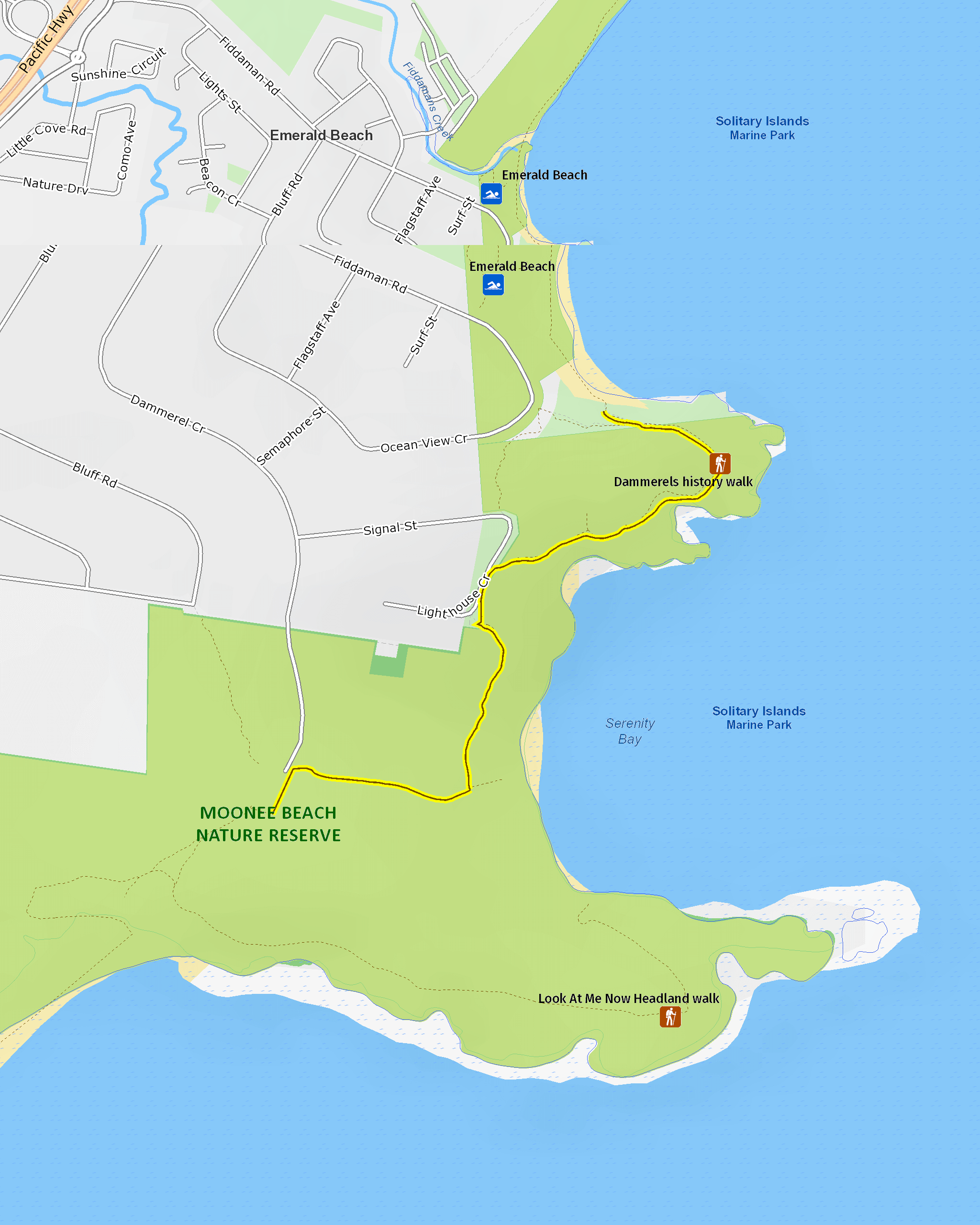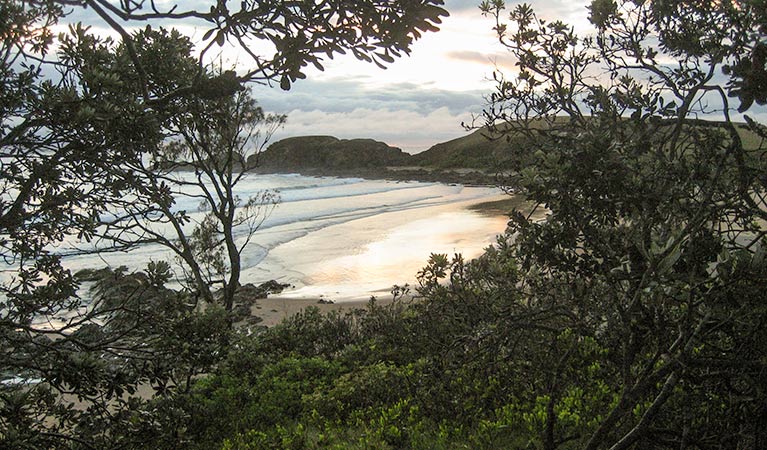Dammerels history walk
Moonee Beach Nature Reserve
Overview
Dammerels history walk is a short, easy stroll taking in historic sites, scenic views and the pioneering heritage of South Solitary Island. Whale watching and birdwatching is recommended.
- Where
- Moonee Beach Nature Reserve in North Coast
- Accessibility
- Medium
- Distance
- 1.9km return
- Time suggested
- 30min - 1hr
- Grade
- Grade 2
- What to
bring - Drinking water, hat, sunscreen
- Please note
- Eastern grey kangaroos inhabit the reserve. They are powerful wild animals capable of causing serious injury if threatened, so please appreciate them from a distance.
- Remember to take binoculars in you want to birdwatch or whale watch
When the Dammerel family took the job as full-time operators of the signal station here in 1884, they could not have known what lay ahead over the next 40 years. Apart from extremely hard work, which the daughters took on as well, the family had their fair share of tragedy, mishap and love stories.
Dammerels history walk is a short easy stroll with a superb view out to Solitary Islands, named by Captain Cook. Learn all about the workings of an historic 19th century lighthouse with a kerosene light and the signal station that provided its only link to the mainland. Hear the story of the Dammerel family and of the collision in 1886 of Keilawarra and Helen Nicoll. Only two bodies of the 48 who died in the accident washed ashore, and their graves are on Dammerels Head.
Watch for wildlife like grazing eastern grey kangaroos, wallabies, goannas and pythons. Pack a picnic and enjoy the scenic views and this fascinating portion of Australian history.
Map

Map legend

Local alerts
For the latest updates on fires, closures and other alerts in this area, see https://www.nationalparks.nsw.gov.au/things-to-do/walking-tracks/dammerels-history-walk/local-alerts
General enquiries
- National Parks Contact Centre
- 7am to 7pm daily
- 1300 072 757 (13000 PARKS) for the cost of a local call within Australia excluding mobiles
- parks.info@environment.nsw.gov.au
Park info
- in Moonee Beach Nature Reserve in the North Coast region
Moonee Beach Nature Reserve is always open but may have to close at times due to poor weather or fire danger.
Visitor info
All the practical information you need to know about Dammerels history walk.
Maps and downloads
Learn more
Dammerels history walk is in Moonee Beach Nature Reserve. Here are just some of the reasons why this park is special:
Rare and threatened

Little bent-winged bats roost in nursery caves on the headlands of Moonee Beach Nature Reserve. Producing only one offspring each year and being particularly vulnerable to disturbance by humans, they are, unsurprisingly, an endangered species. Eastern grey kangaroos are found throughout the reserve and swamp wallabies frequent the coastal rainforests and heathlands. 80 bird species are known, including 10 endangered species, such as sooty and pied oyster-catchers and black-necked storks. Five threatened plant species survive in the salt spray and shallow soil on the surface of the headlands. To the untrained eye these plant communities, hidden within the grass, don't look like much. But to a botanist they are EEC (ecologically endangered communities) and their plight probably keeps some of them awake at night.
- Look At Me Now Headland walk It’s an easy hike along Look At Me Now Headland walk, with scenic views all the way and a lookout over Moonee Beach. This is a great place for whale watching in winter and birdwatching in spring.
- Moonee Creek canoe route For those into kayaking, canoeing or fishing, Moonee Creek canoe route is the ideal alternative way to enjoy the reserve. This pristine estuary is at the southern end of Moonee Beach.
Settling in

The 1880s were a big decade for newcomers to the area and the history is fascinating. From 1884, South Solitary Island signal station was operated by the Dammerel family. Only a couple of years into what would become a 40-year job, there was a collision at sea between Keilawarra and Helen Nicoll. Lone fossicker Frederick Fiddaman spent much of the 1880s searching for gold, and evidence of his toils can still be seen at Diggers Point. A century later, locals protested long and hard, successfully preventing the area becoming a site for sewage ocean outfall. Only in 1995 were Look At Me Now Headland, Diggers Point and Bare Bluff added to the reserve.
- Dammerels history walk Dammerels history walk is a short, easy stroll taking in historic sites, scenic views and the pioneering heritage of South Solitary Island. Whale watching and birdwatching is recommended.
This powerful place

Look At Me Now Headland is significant to local Gumbaynggirr people as an important mythological site and a powerful place within their homeland. Evidence of everyday lives of Aboriginal heritage and its people remains in the form of middens, campsites, ceremonial sites and areas where stone axes were ground. The name Moonee comes from 'Munim-Munim', which is the Gumbaynggirr name for the area. It means 'rocky', reflecting the original importance of this place for axe-making.
- Look At Me Now Headland walk It’s an easy hike along Look At Me Now Headland walk, with scenic views all the way and a lookout over Moonee Beach. This is a great place for whale watching in winter and birdwatching in spring.
Plants and animals protected in this park
Animals
-

Australian pelican (Pelecanus conspicillatus)
The curious pelican is Australia’s largest flying bird and has the longest bill of any bird in the world. These Australian birds are found throughout Australian waterways and the pelican uses its throat pouch to trawl for fish. Pelicans breed all year round, congregating in large colonies on secluded beaches and islands.

